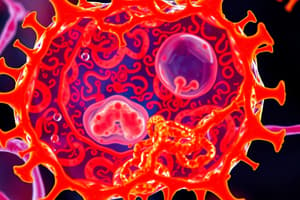Podcast
Questions and Answers
What is the primary function of microvilli?
What is the primary function of microvilli?
- To facilitate communication between cells
- To increase the cell surface area for nutrient absorption (correct)
- To form impermeable junctions between cells
- To protect the cell from mechanical stress
Desmosomes are responsible for facilitating communication between heart cells.
Desmosomes are responsible for facilitating communication between heart cells.
False (B)
What are the three major components of cytoplasm?
What are the three major components of cytoplasm?
cytosol, inclusions, organelles
The __________ are impermeable junctions that prevent substances from passing through between cells.
The __________ are impermeable junctions that prevent substances from passing through between cells.
Which type of junction allows for easy exchange of substances between adjacent cells?
Which type of junction allows for easy exchange of substances between adjacent cells?
Match the cellular structures with their functions:
Match the cellular structures with their functions:
Cytosol is a solid substance found within the cytoplasm.
Cytosol is a solid substance found within the cytoplasm.
What are inclusions in the cytoplasm?
What are inclusions in the cytoplasm?
Which organelle is known as the powerhouse of the cell?
Which organelle is known as the powerhouse of the cell?
Robert Hooke discovered the cell in the 1600s.
Robert Hooke discovered the cell in the 1600s.
What is formed when protein connexins come together?
What is formed when protein connexins come together?
The movement of water from a greater concentration gradient to a lower concentration gradient through a semi-permeable membrane is called __________.
The movement of water from a greater concentration gradient to a lower concentration gradient through a semi-permeable membrane is called __________.
Which membrane protects the heart?
Which membrane protects the heart?
Match the following membranes with their protective roles:
Match the following membranes with their protective roles:
What type of epithelium protects the vagina?
What type of epithelium protects the vagina?
What are the four elements that compose the cell?
What are the four elements that compose the cell?
What is the primary function of mitochondria?
What is the primary function of mitochondria?
The rough endoplasmic reticulum is involved in lipid synthesis.
The rough endoplasmic reticulum is involved in lipid synthesis.
What are the main protein structures involved in the cytoskeleton?
What are the main protein structures involved in the cytoskeleton?
The __________ are known as the cell's 'suicide bags' due to their role in digesting worn-out cell structures.
The __________ are known as the cell's 'suicide bags' due to their role in digesting worn-out cell structures.
Match the organelles with their primary functions:
Match the organelles with their primary functions:
What is the function of ribosomes?
What is the function of ribosomes?
The smooth endoplasmic reticulum has a role in the synthesis of membrane proteins.
The smooth endoplasmic reticulum has a role in the synthesis of membrane proteins.
What is the role of peroxisomes in the cell?
What is the role of peroxisomes in the cell?
The __________ serves as the control center of the cell, where the highest concentration of DNA is located.
The __________ serves as the control center of the cell, where the highest concentration of DNA is located.
What structures are responsible for cell motility and shape changes?
What structures are responsible for cell motility and shape changes?
Which of the following glands secrete hormones directly into the bloodstream?
Which of the following glands secrete hormones directly into the bloodstream?
All connective tissues are poorly vascularized.
All connective tissues are poorly vascularized.
What type of connective tissue is the most abundant and widely distributed in the body?
What type of connective tissue is the most abundant and widely distributed in the body?
Tendons connect ________ to bones.
Tendons connect ________ to bones.
Match the connective tissues with their features:
Match the connective tissues with their features:
What type of epithelium is primarily responsible for rapid diffusion and filtration?
What type of epithelium is primarily responsible for rapid diffusion and filtration?
Which type of muscular tissue is responsible for involuntary movements?
Which type of muscular tissue is responsible for involuntary movements?
Epithelial tissues have a rich blood supply.
Epithelial tissues have a rich blood supply.
Neurons are the only cells involved in the nervous tissue.
Neurons are the only cells involved in the nervous tissue.
What is the primary function of nervous tissue?
What is the primary function of nervous tissue?
What is the primary function of glandular epithelium?
What is the primary function of glandular epithelium?
________ epithelium is found lining the respiratory tract and has cilia.
________ epithelium is found lining the respiratory tract and has cilia.
Match the following types of epithelium with their primary locations:
Match the following types of epithelium with their primary locations:
Which epithelial tissue is highly modified to stretch?
Which epithelial tissue is highly modified to stretch?
Simple columnar epithelium contains goblet cells that produce mucus.
Simple columnar epithelium contains goblet cells that produce mucus.
The lower surface of epithelial tissues rests on a ________ membrane.
The lower surface of epithelial tissues rests on a ________ membrane.
Study Notes
Cell Basics
- Discovered by Robert Hooke in the 1600s; identified as the building blocks of life.
- Composed primarily of carbon, oxygen, hydrogen, and nitrogen.
Cell Structure
- Major components: Nucleus, Plasma Membrane, Cytoplasm, Organelles.
- Nucleus acts as the control center, housing DNA; includes nuclear envelope, nucleoli, and chromatin.
- Plasma membrane consists of lipid bilayers with embedded proteins, regulating substance passage and cell communication.
- Cytoplasm is the 'factory floor' where organelles and inclusions are suspended; contains cytosol.
Organelles and Their Functions
- Mitochondria: Known as the powerhouse of the cell, responsible for ATP production.
- Ribosomes: Sites for protein synthesis; can be free-floating or attached to rough endoplasmic reticulum (ER).
- Endoplasmic Reticulum:
- Smooth ER: Involved in lipid synthesis and detoxification.
- Rough ER: Site for protein synthesis and cell membrane production.
- Golgi Apparatus: Modifies, packages, and ships proteins; acts as the cell's traffic director.
- Lysosomes: Contain digestive enzymes to break down waste and foreign substances (cellular "stomach").
- Peroxisomes: Detoxify harmful substances and manage oxidative stress (convert hydrogen peroxide to water).
- Cytoskeleton: Composed of microtubules, intermediate filaments, and microfilaments; provides support and assists in cell movement.
Membrane Junctions
- Tight Junctions: Create leakproof sheets that prevent substance passage, essential in organs like the intestines.
- Desmosomes: Anchoring junctions that connect adjacent cells to withstand mechanical stress, present in skin and heart tissues.
- Gap Junctions: Allow communication between cells; consist of connexons formed by connexin proteins.
Epithelium Classification
- Types: Simple (single layer) and Stratified (multiple layers).
- Characteristics: Avascular, closely fitting, regenerative, and has specific modifications (cilia/microvilli).
Specific Epithelial Types
- Simple Squamous: Facilitates rapid diffusion (e.g., alveoli).
- Simple Cuboidal: Found in glands (e.g., kidneys).
- Simple Columnar: Contains goblet cells for mucus secretion; lines the digestive tract.
- Stratified Squamous: Protects against friction; found in skin and body openings (e.g., mouth, vagina).
- Transitional Epithelium: Found in bladder; allows for stretch due to its modified stratified structure.
Connective Tissue
- The most abundant and diverse tissue; supports and binds other tissues.
- Vascularized (except tendons, ligaments, and cartilage).
- Distinguishing features include ground substance and fibers (collagen, elastic).
Muscle and Nervous Tissues
- Muscle Tissue: Responsible for body movement; includes voluntary (skeletal) and involuntary (smooth, cardiac) types, with cardiac muscle featuring intercalated discs for ion passage.
- Nervous Tissue: Responsible for signal transmission and processing; consists of neurons and supporting glial cells.
Membranes
- Pericardium: Membrane protecting the heart.
- Pleura: Membrane protecting the lungs; includes parietal and visceral layers.
- Synovium: Membrane that protects joints.
Additional Processes
- Osmosis: Movement of water across a semi-permeable membrane from high to low concentration.
- Diffusion: Movement of solutes from high to low concentration.
- Endocytosis: Engulfing materials into the cell (e.g., phagocytosis).
- Exocytosis: Releasing materials out of the cell.
Studying That Suits You
Use AI to generate personalized quizzes and flashcards to suit your learning preferences.
Related Documents
Description
Test your knowledge on the essential components of the cell, including the functions of the nucleus, mitochondria, and Golgi apparatus. This quiz will challenge you with questions about the discovery of cells and the role of proteins within them. Perfect for students learning about cell biology!




